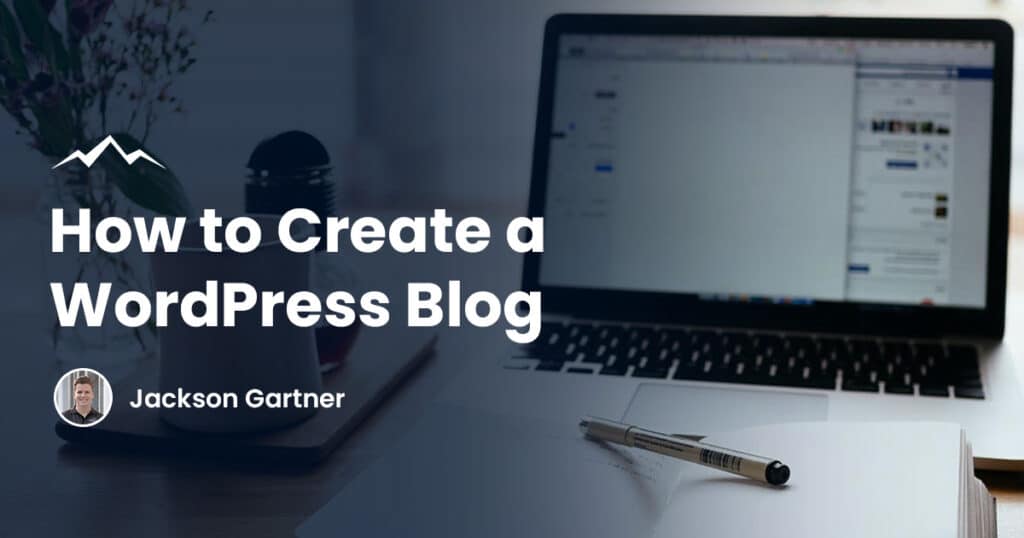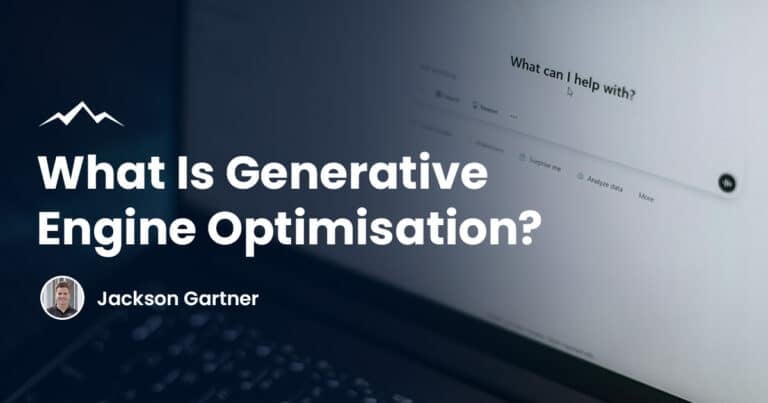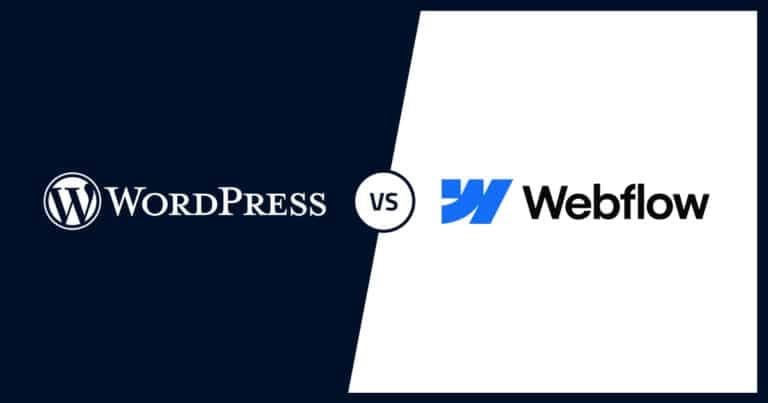In this guide we are going to be running through the ways you can use WordPress for your blog giving you the tools to become a webmaster in your own right!
Let us take you through a step-by-step guide on the beginning stages of using WordPress and everything you need to know to take your blog to the next level.
What Is WordPress?
So before we begin, what actually is WordPress? The main essence of WordPress is that it’s a simple and popular way to create your own blog or website.
With WordPress powering over 43% of all websites found on the internet, to say that it’s popular would be an understatement.
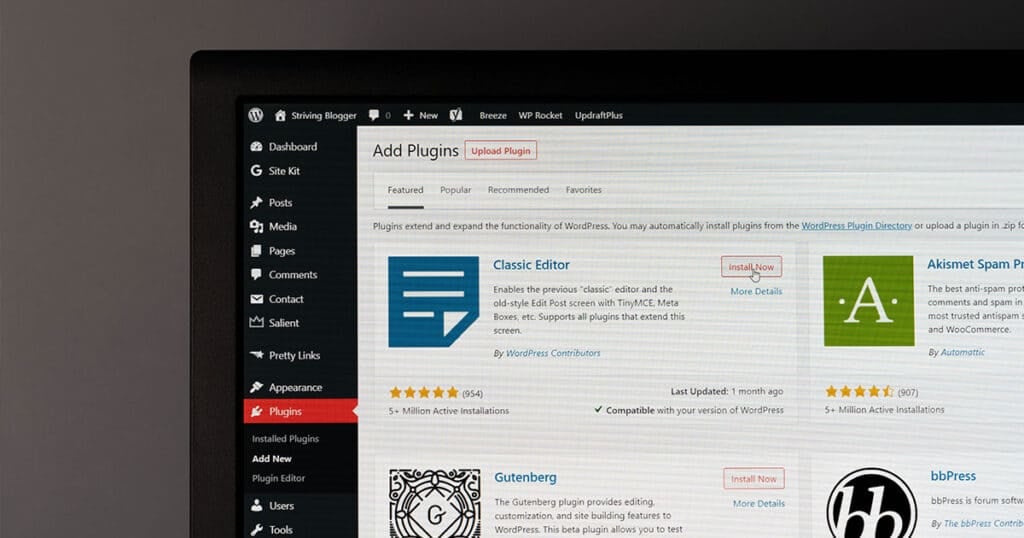
In more technical terms, WordPress is an open-source management system that is licensed under GPLv2. This means that anyone can modify and use WordPress for free.
The CMS or Content Management Tool is the aspect that allows you to easily manage crucial areas of your site, such as content, SEO, and media, without needing any programming knowledge.
The main objective of WordPress is to make website building easy and accessible to everyone – even those with little to no computer know-how.
The Benefits Of Using A WordPress Website To Create A Blog
WordPress has been benefitting bloggers since 2003, and has become the most popular blogging software available.
It’s become popular with non-blogging content over the years and has become the standout choice for many company websites.
Here are 10 benefits that you will receive from using WordPress to create a blog;
- Ease of use – WordPress is easy to use for even the least technically gifted of us. With an intuitive interface, adding pages, images, and blog posts can be done on a regular basis quickly and easily. Due to this technology being so simple to use, less time is spent formatting your website.
- Manage your website from any computer – WordPress is browser-based software, meaning you can log in from any computer and manage your site with the correct login credentials entered.
- No HTML Editing or FTP Software Needed – Being a self-contained system, WordPress.com does not need HTML editing software. The creation of new pages, formal text, blog post, document uploads, image uploads, etc., can all be completed without the need for an additional FTP or HTML software such as Dreamweaver or Adobe Contribute.
- Search engine friendly – Codes that are used behind any site created with WordPress.com are clean and simple, making them search engine friendly. Every page and post, image, and video can include its own meta description or tag keyword creating a more optimised format for specific search engine keywords. This allows for precise search engine optimisation with tags focusing on subcategories of the subject niche.
- Complete control – The need to wait for a website designer has gone – WordPress.com make things simple and easy for their users. You gain control of nearly every aspect of your WordPress blog making updates quick to complete for yourself.
- 100% customisable – WordPress is the powering force behind your website. You can customise the look and feel however you want it, allowing full creative control of your site. This gives your readers and visitors a unique experience, allowing them to gain a better encounter when visiting your site compared to other niche relevant competitors.
- Blog friendly – WordPress was originally created as a blogging platform. This is a key aspect in why the capabilities available for bloggers is so great. There are many unique and useful features that you can only get with a WordPress blog, and they have all been designed to be simple and easy to use.
- Functionality extending plugins – Extended functionality can be acquired with the addition of plugins. WordPress plugins can be found free of charge or more premium options costing a small amount. They’re all reasonably priced and can be a great way to optimise your website.
- Grow your blog as your business grows – The scalability of WordPress sites is outstanding, allowing you to have hundreds, if not thousands of pages and still no performances lost within your domain.
- Multiple users – Being an administrator of a WordPress site means you can assign multiple levels of access control to other users. This is great if you have a team working behind a website, each member having a specific role.
Need more information on the benefits for your business? Talk to one of our dedicated WordPress developers.
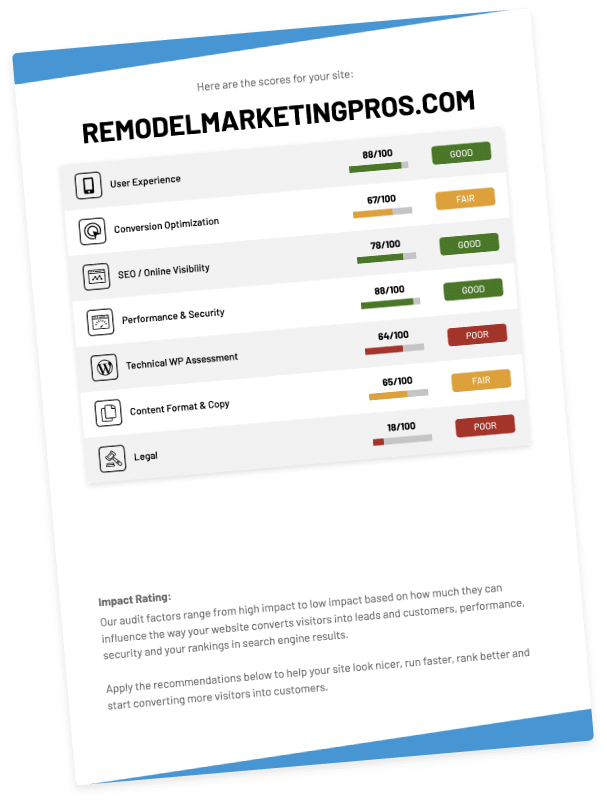
How To Start A WordPress Blog
When starting a blog, the best place to begin is with WordPress, mainly due to how easy it is. However, if you’re going to start a WordPress blog for the first time, it can be daunting to look at.
With so much functionality offered, WordPress cannot be used to create a blog with intuition alone. There are lots to think about, such as settings, plugins, themes, domain and much more.

With all this in mind, we have created an easy step-by-step guide to help you get started in the world of WordPress blog creation. This is a basic guide to get your first blog post ready for a reader to see and enjoy.
Follow these steps, and become a WordPress blog master in no time!
1. Choose a Hosting Provider
When it comes to finding a hosting provider, there are lots of choice with hundreds, if not thousands, available.
Like most things in life, the best web hosting provider is not going to be free, and if you do find one that is, it’s probably not going to be worth your time and effort.
Choosing a hosting provider with a monthly fee will be much more worth it in the long run, and there are some good ones to choose from, ranging between $3 and $35 per month.
Not sure what website hosting is exactly? Check out our website hosting blog here.
Bluehost Shared Hosting for WordPress
One of the most popular names in web hosting is Bluehost. Bluehost offers a range of annual and monthly payment plans. For new customers, your luck is in. There are deals such as $2.95 per month for a year to be found, so keep your eyes peeled for the best deal you can get.
If you’re a blog post beginner, Bluehost is a great choice giving you a budget-friendly way to step into the blog posting world.
Flywheel Managed WordPress Hosting
With plans starting at $23 per month, Flywheel is a little more expensive than Bluehost, but they offer a lot more for that price.
Flywheel is a WordPress hosting company. With this WordPress specialisation, there are many offers to be taken advantage of, such as free resources like ebooks, videos, and help books that can give you tutorial guides in becoming a WordPress wizard!
WP Engine Managed WordPress Hosting
WP Engine is a complete WordPress optimised hosting provider. They offer plans starting from $35 per month, but some offers can be found online, giving you a 10% discount on initial payments. WP Engine is a little more expensive than some other web hosting providers available, but they are the true WordPress experts who have a lot of trust around the world wide web.
For a blog post beginner, any one of these 3 web hosting companies are a great choice. Bluehost is the most budget-friendly service and have more than enough proficiency to host a new blog. If you can afford to spend a little more, it is recommended that you use WordPress specialists such as WP Engine or Flywheel.
A hosting service like this can manage your entire server, providing you with core updates to keep your blog running smoothly. Safety is secured with each hosting service, too, with backups and security scanning offered by both Flywheel and WP Engine.
No matter if you want a WordPress specific host or a less expensive hosting provider such as Bluehost, all of these plans will work great with your new WordPress blog.
This is the most popular way to start a blog page by many, with it being easy to use, offering lots of flexibility and the many amazing features available. Plus, it can save you loads of money over time with all the plugins and themes available.
2. Pick a Domain Name
After you’ve decided which hosting platform is right for you, it’s time to pick a domain name. The domain name is the address of your website or blog on the internet. For example, wordpress.com and google.com.
When you have finalised your hosting plan, you will be able to choose your websites domain name.
How to Choose a Domain Name?
So what kind of domain name are you looking for to represent your WordPress blog? Websites can use different suffixes, which used to make a difference in the authority of your website but have become less important in recent years. Website suffixes are the letters on the end of your website address such as .com, .net, .org, etc.
So the suffixes don’t matter too much, but you should have a careful think of how you would like your domain to look. The best practice is usually a shorter domain name, being a better domain name.
Using something easy to read, easy to spell, and easy to remember will give your visitors more scope in revisiting your WordPress blog. Subject, niche-specific branding is also a great idea.
If your WordPress blog domain name isn’t related to the content you’re posting, it won’t really bring any continuity to your brand or appear in searches of people looking for content in that subject.
Alternatively, a lot of personal blogs use the name of the writer or an alias name. If you want to promote yourself rather than your content niche, to you’re covering many areas, this is a great idea.
3. Install WordPress
Using one of the three hosting plans we mentioned earlier will help you start your blog in the right way with them being totally compatible with WordPress.
After you’ve chosen your favoured hosting plan, you will need to install and set up WordPress for your website.
The installation of WordPress varies a little depending on the web hosting provider you have chosen. This is nothing to worry about, though, and your site should be live in no time, ready to make your first blog post.
- When using Bluehost, you will be presented with a speedy one-click set-up after signing up. You simply need to install WordPress when prompted; from here, follow the on-screen instructions like entering your domain name and creating your login details.
- If you have chosen a plan with Flywheel, WordPress comes pre-installed and ready to use. One thing with Flywheel hosting plans you should know is that only one website is permitted per hosting plan. This means you need to add a domain, create your WordPress login information or migrate an existing website from a different location. This can be done with help from the Flywheel team, who will do their best to get you started on your WordPress site.
- WP Engine is similar to Flywheel, with it being a managed WordPress hosting site meaning there isn’t a need to install WordPress as it is already pre-installed. Using WP Engine means you will need to add a new domain or migrate your existing website. To migrate, you just need to log in, and then go to Install then Site Migration. If you have chosen one of the pro WP Engine plans or higher, you can add multiple websites to your hosting plan, giving you accessibility to all your websites in one place.
- If you’re using a different host from the three we have recommended, not to worry. WordPress can be installed on any hosting service, you may just have to download and install WordPress manually.
When you have successfully installed WordPress, you should be able to log in via your URL. From your hosting account, you should find a link that will log you into WordPress.
Use the administrator name or email and password that you chose when creating your initial hosting account.
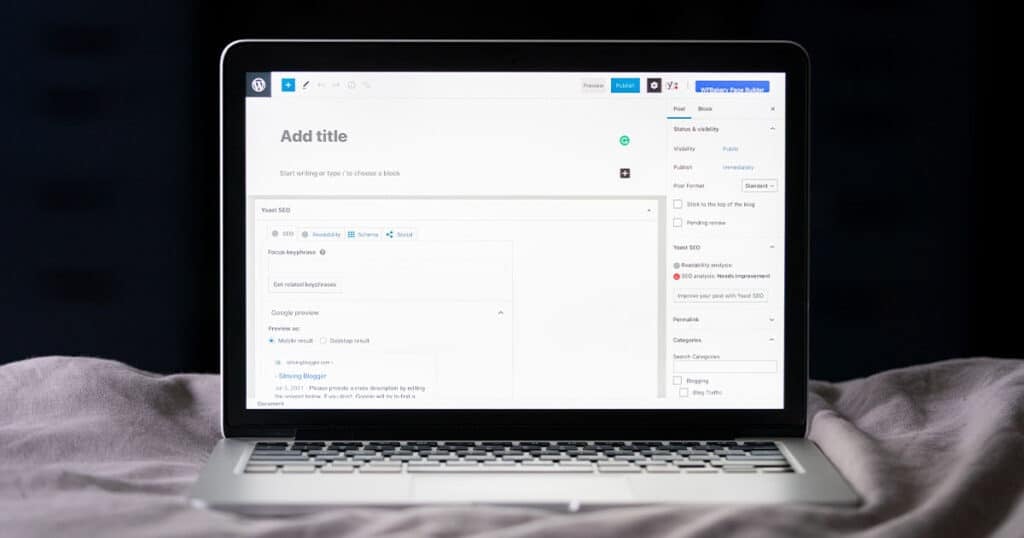
WordPress is an open-source software meaning it is 100% customisable, but within this guide, we will refer to the settings found in your WordPress dashboard.
Being aimed at beginners, we believe this is the best way to begin. Hovering over the Settings menu in your sidebar will present a variety of different options.
At first glance, these settings may look a little intimidating, but this doesn’t have to be the case. You only need to familiarise yourself with a select few of these settings at this beginning stage, making things a little more simple.
The settings you should take note of are as follows;
General Settings for WordPress
In the general settings, the most important areas are your Site Title and your Tagline. These both can be altered at any time, but it is good practice to understand both of these areas as you can create a better brand continuity throughout your WordPress site.
The title of your WordPress site is usually the name of your brand, or maybe even your personal name/alias name for a personal blog. Easy stuff, right?!
Your tagline should take a little more thought as it will describe your entire blog. Think about why you decided to start a blog, and present a true representation of what your WordPress blog is going to be. If you wish, the date and time format can be changed in this area too.
Writing and Reading Settings for WordPress
Your writing settings help you create a Default Post Category and Post Type for the articles you’re posting. This being the beginning of your WordPress blog posting journey, these settings can be revisited at a later date. It isn’t the most crucial step, but it can be a great way to improve your blood posting speeds.
In the reading settings tab, you can decide what your WordPress homepage displays. This will be based on the theme you’re using and could be set featuring a static custom page or even your latest blog post. There are lots of options so you can have a play around with it.
WordPress Discussion Settings
The discussion settings feature all of the relating comments on your WordPress website. When it comes to the discussion settings, your main worries should be whether you want to allow people to make comments, and if so, should they be manually approved for display.
Other settings are available within the discussion tab, but these are pretty much ready to go using the defaults.
WordPress Media Settings
The WordPress media settings are where you can find all your image controls for your website. WordPress has thumbnail, medium, and large image cropping sizing options, giving you lots of choices.
Media can be customised how you like or just be left how they are; it is entirely up to you.
WordPress Permalink Settings
Permalinks are found in your browser address bar when a site visitor is on any page of your WordPress site. Your permalink is your websites URL, along with the individual page or post identifier.
Within these settings, you will be shown all the varying permalink formats available for your WordPress website. As a default, WordPress will set your permalink in a not very attractive way.
We recommend that you change it to the Post Name option. This option is much more aesthetically appealing and adds valuable SEO boosts to your website.
Note: After the initial selection and changing of your permalink structure, you should avoid making any changes without some prior preparation. Altering permalinks without the proper planning may result in broken links and 404 errors within your WordPress website, negatively impacting your websites SEO throughout.
Your WordPress Profile
Along with these general WordPress settings, it is a good idea to look into your user profile. This can be found under Users > Your Profile or by selecting your name on the top right of your screen.
The details that are found in these settings are usually displayed by themes making it important to check that all the information that has been entered is correct.
Make sure your Display name drop-down options displays the name you want the world to see.
This display name is created with a choice between your first, last, user, or nickname. If you want a bio and your chosen theme supports this, remember to complete this section too.
Finally, a Gravatar will need to be set up. This will be using the same email account as your WordPress login with an image you would like to use as your profile picture.
This picture could be a nice looking headshot of yourself or some sort of graphic that relates to your website to keep the brand identity contingent.
4. Make Your First Blog Post!
If you have followed our step-by-step guide so far, your WordPress blog should be well on its way to be ready for content production, but before this takes place, there are a few simple tasks you need to complete.

The first of these is removing the sample page, post, and comments that WordPress include by default in their themes.
Deleting Sample Pages and Posts
Start by selecting the Pages menu in the sidebar. Here you will find one sample page of content that can be deleted by hovering and selecting the Trash button.
You don’t need to create any new pages for now, but you may want to create an About or Contact page at a later date. Our step-by-step guide focuses on getting you to a starting point for blog posting, which doesn’t include these extra areas.
Click Posts located in the sidebar, and just as you did within the pages menu, delete the sample content. This will be titled ‘Hello World’, so it should be easy to find.
Now your WordPress blog is clean and fresh, ready for your finely crafted content.
Create Your First Post
So the time has come. It’s blog post time. From the sidebar, go to Posts and select Add New, where you will be taken to a new screen.
When it comes to getting your first blog post live on your site and out in the world, there are three key areas you need to check:
- Create a captivating title for your blog post: Your title will go in the section directly underneath the ‘Add New Post’ tab. Your title should be catchy, concise, and clear. Including a relevant keyword is also an excellent idea helping with SEO.
- Write your content: You will notice a main text editor box. This is where the bulk of your writing should go. This editor is known as a WYSIWYG (what-you-see-is-what-you-get). This means you will see any edits such as adding bold, italics, links, font sizes, etc., live in front of you rather than waiting for the published blog post to represent these alterations. This is also the same for any media, such as images or video links you include in your WordPress blog post.
- Featured image, category & tags: Additions of any images should happen now! Using categories and tags such as broad post groupings and niche-specific descriptions are recommended. They make it easier for the returning readers to browse through your WordPress blog without scanning through hundreds of potential blog posts.
If you have all three of these areas covered, it’s time to click that almighty publish button— and give yourself a pat yourself on the back. You’ve done it! WordPress content creation is that simple! This being said, there are many more ways you can optimise your blog posts and present your website in a better way, but the key for all WordPress beginners is to get things started!
More detail and meticulous setting changes can be added later on. Concentrate on getting your content out into the world in the beginning, and work on those extra steps at a later date.
Add More Features
The great thing about WordPress powered websites is that you can add loads of additional features. Your WordPress dashboard allows you to add extra WordPress plugins, add a new style, or choose a new theme. The possibilities are endless. This being said, there are a few common features that are regularly added to WordPress websites, most simply requiring a plugin.
- WordPress Forums
- Shops
- Google Fonts
- Page Builder
- Customisation of your website design.

How To Optimise Your WordPress Blog
Know What You Want To Write About
So let us dial it back a bit. Right to the very beginning, what is your WordPress blog going to be about? When starting at the beginning, you have complete niche freedom. The only requirement is to write about something you’re interested in.
You don’t have to be the leading WordPress website on your chosen topic, but you need an interest and a desire to learn to stay interested in the content you’re creating. The choice of blog topics is broad, with nearly anything and everything available for you to begin writing about.
A good way of starting is to research competitors in your chosen niche and see what is missing. If you can offer something no one else is offering, you’ll be onto a winner.

Regarding topics, categories there is a broad selection, but try and pinpoint a subcategory within that niche. Music is a broad topic, but a WordPress blog may cover live reviews, album reviews, solo musicians, different music genres, critics, instructors, and much more.
It’s not just a case of choosing a topic. It is about how you want to blog about that particular topic. A music critic compared to an active musician will both share their views on music but will have two blogs completely different.
Although you may have a predominant topic, this doesn’t mean you cannot blog about any other areas. There are many niche crossovers, so experimenting is a great way to hit new targets for the optimisation of your WordPress website.
Use a WordPress Theme
When it comes to your WordPress theme, you can take hours on end scrolling through different layouts to suit your blog. However, it’s not needed, because to be completely honest, your WordPress theme isn’t that important when you’re just beginning.
Every beginner’s main focus should be creating quality content and getting it in a position that is reaching people. Web design is only important when it comes to having a sizable audience. If you don’t have any traffic coming your way, blog design isn’t that important as nobody sees it.
As a default, yearly WordPress themes will be activated onto your website. Automattic, who are also the creators of WordPress, release a new theme every year, and each one is catered to the needs of a blogger.
These WordPress themes are designed to help beginner blog creators, giving them a better start to using a WordPress website.
As you build and grow your WordPress blog, extra features will be needed, so a switch of theme could be a good idea. Switching your WordPress theme is easy, as all you need to do is install the new theme. This can be done in your sidebar following these navigation steps Appearance > Themes > Add New.
When you’ve done this, simply click the upload button and choose the theme zip file you would like to upload, then install the selected theme and activate it.
Congratulations! Your new premium WordPress theme has been installed, giving you all of the new features you’ve need to optimise your WordPress blog making it more suitable for your ever-growing audience.
A premium theme will offer more features and capabilities than you would find with a free WordPress theme, so it is sometimes beneficial to spend that little extra money.
Use WordPress Plugins
Themes are the first hurdle for WordPress bloggers, and plugins are not too far behind. WordPress plugins take a long time to instal, and hours can go by without much done regarding content creation.
For a WordPress website, you don’t actually need any plugins to start blogging. When you first install WordPress, you’re already well equipped to begin blogging, but a few plugins are recommended to install and activate to get more out of your WordPress blog.

It is worth noting that WordPress plugins are free and can be found on your WordPress dashboard via the sidebar.
Use the search bar to browse for your free plugins, or if you’ve downloaded from somewhere else, you can click to upload the downloaded software.
When you’ve successfully found the WordPress plugin you desire, click ‘Install Now’ on the link found. When your plugin has finished installing, you will be directed to activate your new plugin. When it is activated, you’re done!
Now that your plugin has been successfully installed and activated, here are a few of the vital WordPress plugins we believe everyone should take a look at;
Spam Protection – Akismet
Spam comments can be a big problem later down the line if you don’t deal with them in the early stages of your blog creation. The best WordPress plugin for this is Akismet. It’s easy to use – simply install, activate, and then decide the strictness level regarding the comments you receive.
Akismet will automatically check and scan your comments and remove suspicious comments straight to your spam folder. The only job you need to remember is to empty your spam folder from time to time.
Social Sharing – AddThis
If you want people to share your WordPress website, you need a theme that supports social sharing, and if you don’t but love the way your theme looks, do not fear. AddThis is the WordPress plugin you need to install. A free plugin that allows social sharing for over 200 social networks.
They feature lots of button styles and locations, which is great for customisation. If you want to view any of your analytics without Google Analytics, you will need to choose a premium version. This premium account is also needed for more advanced sharing options. The free version is ideal for WordPress bloggers, though, with lots of features available.
SEO – Yoast
SEO or Search Engine Optimisation is a key area to any website that wants to rank higher in Search engine queries. Becoming a true SEO expert takes years of practice and can never be completely learnt, with updates forever changing.
An SEO plugin such as Yoast SEO is a vital area for your WordPress blogging needs. Yoast is great as it offers basic SEO options such as keyword optimisation, titles, breadcrumbs, exerts, and more.
Google Analytics – Site Kit by Google
If you want to track how well your WordPress website performs, a great site to visit is Google Analytics. With an account set up, you can monitor your website through a tracking code to your site.
Manual checks can be completed every day, but with WordPress being a flexible CMS, there are many plugins that will integrate your WordPress website analytics into your WordPress dashboard.
Hence, there is less need to use Google Analytics. Site Kit by Google is great as it works perfectly with other tools such as Yoast SEO.
With these two plugins working together, you can combine your SEO strategy plans with SEO monitoring for better results overall.
WordPress Backups – VaultPress
So, you’ve created the perfect theme and web design for your blog, your content has been optimised, your domain name is niche perfect, and your site is ready to go live, then crash. For some reason, everything has disappeared, and you need to install WordPress again.
This may be a dramatic turn of events, but it may have happened to some people out there, and did they backup their work? I don’t think so. Plugins such as VaultPress are great to maintain a complete site backup, always leaving you with a plan b if something goes wrong.
If you want to start a blog, ensure that you keep a saved backup file of your stages so there isn’t any chance that you will lose your progress. VaultPress is a free plugin, but requires a monthly membership to embrace the full spectrum of features it offers.
Monetise Your Blog Posts
There are several ways you can create money from your blog page, but today we will focus on two of the main methods:
- Ads: Sometimes known as banner adverts, these are great ways for you to earn a constant cash flow from your blog. This visual advertising form will place adverts on your blog page that people will see they visit your site. The two ways to earn money from ads are either CPC or CPM. CPC stands for cost per click and will create revenue every time an advertisement is clicked. CPM stands for cost per mile. This is where every 1000 views of the ad banner will result in you receiving a sum of money. Ads are great if you’re receiving a lot of traffic but may not earn you much if you have few visitors.
- Affiliate Marketing: Affiliate marketing is the process of earning money from promoting other peoples brands or products. There are different variations of affiliate marketing, but the most suited to bloggers is promotion through text and unique hyperlinks to the product page. If someone clicks through your website and purchases a product, you will earn a cut of the commission. This works through the cookies found on your website, and different affiliate programs will have varying terms and conditions regarding cookie cooldown periods.
Search Engine Optimisation
SEO has been mentioned a little, but we would like to take a more in-depth look into this important part of WordPress Website building and ranking. SEO or Search Engine Optimisation is the science behind making your content visible to a wider audience.
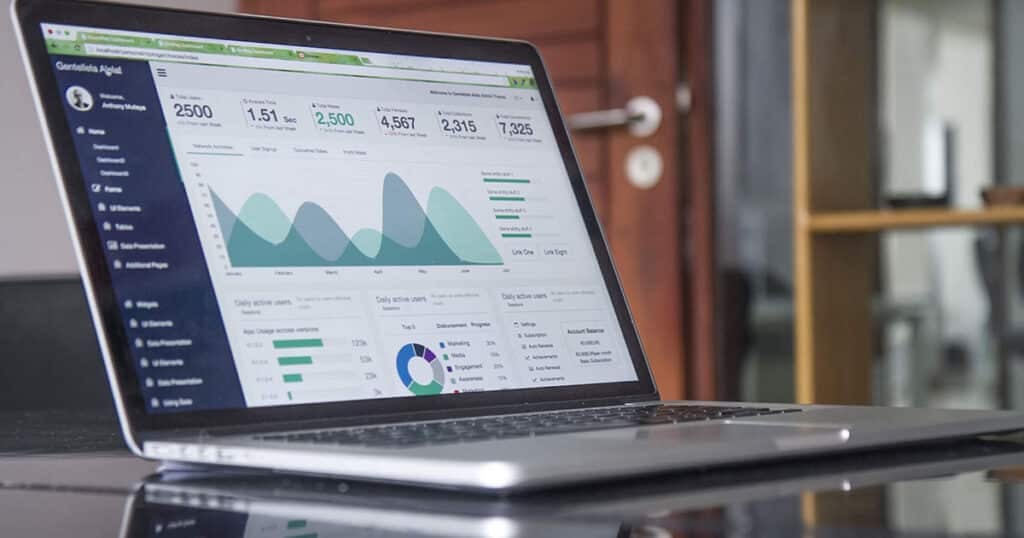
If your related niche subject is searched in Google, you want your page to be one of the first results that appear.
Search engine users tend to click on the first few results, so if your site is in a higher position, there is more chance it will be clicked on, providing more traffic for your blog.
Larger companies will hire SEO firms or professionals to boost their site, making them more successful, but there are key things blog writers can do to boost their posts and optimize the SEO on their site.
- Meta Titles & Meta Descriptions — Meta titles and descriptions are the titles and descriptors you find when completing your initial google search. They should be topically relevant while also being catchy, making them appealing to the reader.
- Keyword Research — When writing an article on your blog, keyword research can be vital in knowing what specific words people are searching for related to your subject.
- User Experience — User experience can be affected by several different reasons, with the most crucial being blog design, loading speeds, navigation, and mobile device compatibility or optimisation. You want your readers to navigate through your blog easily and to be quick to do so. Reducing your images’ size can be a great way to reduce loading speeds and ensure your website looks great on a mobile device.
- Competition — Research who your competition is and see what articles they are ranking well for. This will give you inspiration and a good idea of the areas you need to improve your own blog.
- Value — Finally, but most importantly, you need to think about the kind of value you’re giving to your users. Always aim to give them the best experience possible.
Final Thoughts
Starting your journey of creating a WordPress blog is easy as a beginner. Following our initial step-by-step guide will get you in a great position to showcase your amazing content to the world.
With advancing knowledge and becoming a WordPress master, you can begin developing skills and spending time tweaking plugins, themes, optimisation, and other areas.
The best bloggers will always go back to old content, giving it a new lease of life with more authority.
In the beginning, and most cases, site visitors aren’t going to be worried about the design of your blog or the flash WordPress plugins you have included. They will be more interested in the content you’re producing.
Start a blog, and make it a good blog – don’t start a blog to make it look good. This can come at a later stage. Be creative in your writing, and your audience is bound to grow!
Need some help moving forward with a WordPress solution? Talk with our Brisbane web design team for the latest information.
FAQs
Is WordPress a good place to start a blog?
WordPress is a great place to start a blog. When the software was created back in 2003, its initial objective was to enable blog writers to create a better site for their platform.
The addition of a domain name, SEO optimisation, and ease of access makes WordPress the perfect tool for bloggers.
Is WordPress free for blogging?
WordPress can be free for blogging, with plugins and themes catered to bloggers needs. It is the ideal place to start blogging on a budget. Although there are paid additions and extras available for WordPress, it is predominantly free in all senses of the word.
You can download WordPress for free, and you can edit it as much as you like when you have it for free. WordPress software is published under GNU General Public License. This means it is free to download and is free to customise, use and edit.
How can I make my WordPress blog seen by a lot of people?
To improve the visibility of your WordPress blog, you need to focus on the SEO within your site. SEO or Search Engine Optimisation is the key areas behind making your content more visible to a greater audience.
Areas such as keyword research, page speed, meta descriptions, and niche subject continuity will help with your SEO ensuring your blog is found higher up on search engine results. People are more inclined to visit sites higher in search engine results, so the better you can be placed will directly correlate to the volume of traffic you receive on your site.
Is self-hosted WordPress better than hosted WordPress?
For personal blog users who don’t really care about the monetary potential, there is with a website then the free WorPress.com is the best choice for you being a hosted version. For business owners or bloggers who want to make money from their site, self-hosted Wordpress.org will be a much better choice.
With a self-hosted site, you will gain all the flexibility and freedom needed to grow your website in the exact way you desire. While there are many advanced features found in WordPress.com business plans, your money can go a lot further with a self-hosted WordPress site and will also cost less overall.
It is our opinion that choosing a self-hosted version of WordPress is a better platform to choose. Big-name brands use this version and for a good reason. The monetary value you can get with this kind of WordPress version is much grander than that of a WordPress.com site.
To your success,
Jackson
